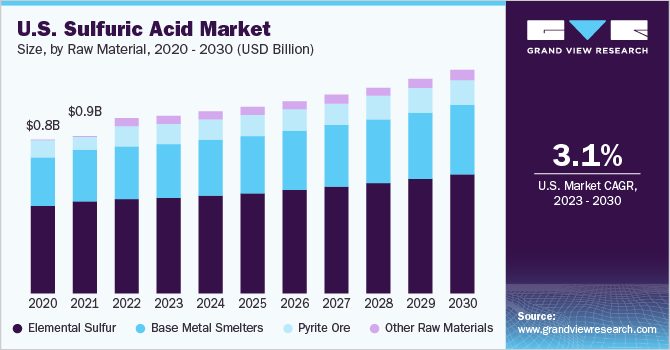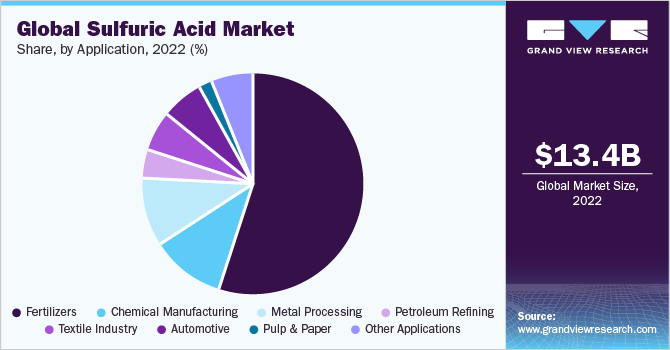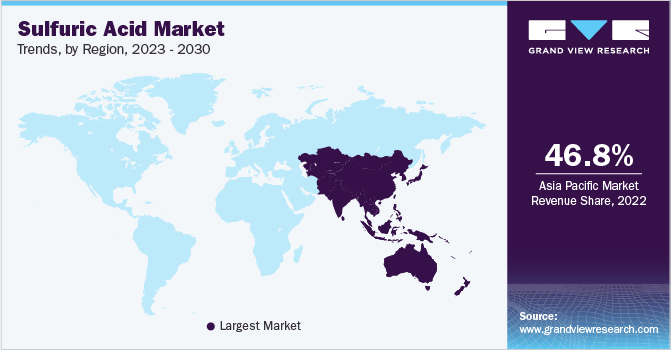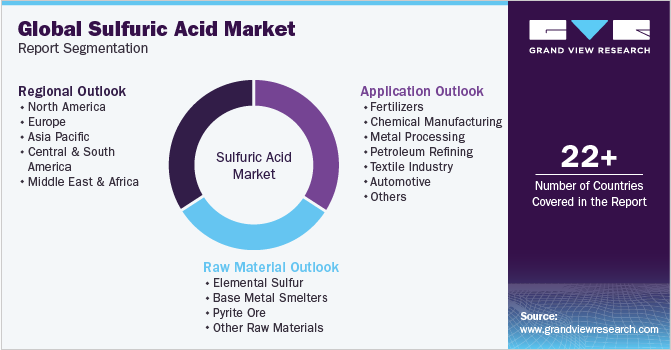- Home
- »
- Organic Chemicals
- »
-
Sulfuric Acid Market Size, Share And Growth Report, 2030GVR Report cover
![Sulfuric Acid Market Size, Share & Trends Report]()
Sulfuric Acid Market Size, Share & Trends Analysis Report By Raw Material (Elemental Sulfur, Pyrite Ore, Base Metal Smelters), By Application (Fertilizers, Automotive, Textile Industry), By Region, And Segment Forecasts, 2023 - 2030
- Report ID: GVR-2-68038-231-0
- Number of Report Pages: 130
- Format: PDF, Horizon Databook
- Historical Range: 2018 - 2021
- Forecast Period: 2023 - 2030
- Industry: Bulk Chemicals
Report Overview
The global sulfuric acid market size was estimated at USD 13.39 billion in 2022 and is anticipated to grow at a compound annual growth rate (CAGR) of 3.7 % from 2023 to 2030. The growing demand for sulfuric acid (H2SO4) from the metal processing industry in the removal of rust and other contaminants from different metal surfaces including iron, steel, copper, and aluminum is anticipated to positively impact the market growth over the forecast period. Sulfuric acid is a highly corrosive and strong mineral acid that is extensively used in various industries, including chemical manufacturing, fertilizers, metal processing, textile production, pulp and paper, and automobile manufacturing. It is composed of the elements sulfur, oxygen, and hydrogen, and is sometimes referred to as oil of vitriol.

The use of H2SO4 in the production of phosphate fertilizers improves the efficiency and effectiveness of fertilizers. In addition, the production of high-quality phosphate fertilizers ensures that crops get the necessary nutrients for growth and development. Moreover, increasing investments in plant facilities due to the rising production capacity of phosphate fertilizer and tightening environmental regulations are anticipated to spur the market over the foreseeable period. However, the production of sulfuric acid releases toxic emissions, which are harmful to the environment and humans. The sulfur emissions result in acid rains, which lead to environmental problems. Acid rains cause the degradation of cement and limestone along with leaching critical soil nutrients, which affects plants, and thus, it acts as a restraining factor in the growth of the product market.
The U.S. is the largest consumer of H2SO4 in the North America region with a revenue share of 48.2% in 2022. The increasing demand for H2SO4 in the textile industry, phosphate fertilizer industry, steel pickling, and petroleum refinery applications is expected to spur market growth in the region over the forecast period. According to the National Council of Textile Organization, the U.S. is the third-largest exporter of textiles where total textile exports accounted for USD 65.80 billion in 2022. The textile industry in the U.S. invested USD 20.90 billion in new textile plants and equipment in 2021. The advancing textile industry in the U.S. is anticipated to drive the demand forH2SO4over the forecast period.
Raw Material Insight
The elemental sulfur segment dominated the market with a revenue share of 53.8% in 2022. This growth is attributed to its easy accessibility & abundant availability, low cost, and less emission than pyrite ore & base metal smelters. In addition, the use of solid sulfur allows for more precise control in the reaction process, which can improve efficiency and reduce waste. The pyrite ore raw material segment is also anticipated to witness significant growth over the forecast period. This mineral resource is used to produce H2SO4, specifically when elemental sulfur is not easily accessible. To manufacture H2SO4, pyrite undergoes a process called the "contact process," where sulfur dioxide gas is oxidized to sulfur trioxide, which then dissolves in water to produce sulfuric acid.
While pyrite is vital in multiple industrial applications, using it as a raw material for H2SO4 production poses environmental hazards. The primary concern with pyrite usage is the risk of acid mine drainage (AMD), which occurs when pyrite-containing rocks react with water and air, leading to the production of H2SO4. AMD can cause significant damage to the ecosystem by harming plant and animal life and increasing soil and water pollution. Despite these concerns, pyrite remains a valuable resource for producing H2SO4. Hence, it is imperative to manage its usage cautiously to minimize any potential harm to the environment. Thus, the critical objective is the optimal utilization of pyrite while preventing its harmful environmental consequences.
Application Insight
The fertilizers segment dominated the market with a revenue share of 54.8% in 2022. This growth is attributed to the fact that H2SO4 is commonly used in the production of fertilizers due to its strong acidic properties and capacity to break down raw materials and create the necessary nutrients for plant growth. The process involves combining H2SO4 with other substances, such as ammonia, to create ammonium sulfate and other types of nitrogen and phosphate-based fertilizers. Chemical manufacturing is another segment anticipated to witness growth over the forecast period. H2SO4 is one of the most widely used acids in the chemical industry.

It is used in numerous manufacturing processes across a broad range of industries. This strong acid is utilized for its highly reactive chemical properties, which can facilitate the production of many essential chemicals. This includes the production of plastics and polymers, as well as the synthesis of industrial chemicals, such as hydrofluoric acid, nitric acid, phosphoric acid, and aluminum sulfate. The textile industry is also anticipated to witness rapid growth over the forecast period. One of the primary uses of H2SO4 in the textile industry is as a catalyst in dyeing natural fibers, such as wool, silk, and cotton. It activates the dye molecule, making it more likely to bond with the fibers, improving the colorfastness and dye uptake of the fabric. This process is commonly known as acid dyeing. In addition, sulfuric acid is also used to prepare synthetic materials, such as polyester and nylon.
Regional Insight
The Asia Pacific region dominated the market with a revenue share of 46.8% in 2022. This growth is attributed to increasing strategic developments, such as the setting up of production plants owing to the booming chemical industry and ease of availability of raw materials for sulfuric acid production, which is projected to propel the market growth over the forecast period. According to the Organization for Economic Cooperation and Development and Food and Agricultural Organization (FAO), Asia Pacific is the largest producer of agricultural commodities and is anticipated to account for 53% of global agricultural product and fish output by 2030. The region's arable land is shrinking, and food demand is rising due to the growing population. Therefore, farmers are increasingly using phosphate fertilizers to increase crop yield, in turn, boosting the product demand in the region.

Europe is also anticipated to witness considerable growth over the forecast period. According to the European Federation of Pharmaceutical Industries and Associations, Germany, Switzerland, and Italy are the leading hubs for pharmaceutical production accounting for Euro 32.3 billion, 53.2 billion, and 34.3 billion, respectively, in 2021. Moreover, according to the European Federation of Pharmaceutical Industries and Associations, the region witnessed a sale of 23.4% of the global pharmaceutical sales in 2021 with total spending on healthcare accounting for 9.3% of the region’s GDP. Thus, the advancing end-use industry in the region is anticipated to drive the demand for the product over the forecast period.
Key Companies & Market Share Insights
The global industry is highly competitive due to the presence of numerous manufacturers and suppliers. These companies use various approaches to meet the growing demand and increase their reach globally, all while keeping distribution costs in check. To make the most of the opportunities presented by the global market, enterprises are resorting to strategies, such as mergers, acquisitions, joint ventures, and expansions. For instance, in June 2023 Sumitomo Corporation announced the acquisition of Saconix to expand its sulfuric acid business in North America to cater to the rising demand for the product. Some of the prominent players in the global sulfuric acid market include:
-
The Mosaic Company
-
AkzoNobel N.V.
-
BASF SE
-
PVS Chemical Solution
-
Solvay
-
Agrium Inc.
-
INEOS
Recent Development
- In August 2022, PVS Chemicals, Inc. partnered with Energy Systems Group, LLC. This partnership intended to increase the sustainability of its Chicago sulfuric acid factory by collecting waste steam and generating 2.6 MW of renewable power viasteam turbine generator
Sulfuric Acid Market Report Scope
Report Attribute
Details
Market size value in 2023
USD 13.53 billion
Revenue forecast in 2030
USD 17.94 billion
Growth rate
CAGR of 3.7% from 2023 to 2030
Base year for estimation
2022
Historical data
2018 - 2021
Forecast period
2023 - 2030
Quantitative units
Revenue in USD billion, volume in million tons, and CAGR from 2023 to 2030
Report coverage
Revenue forecast, volume forecast, company ranking, competitive landscape, growth factors, and trends
Segments covered
Raw material, application, region
Regional scope
North America; Europe; Asia Pacific; Central & South America; Middle East & Africa
Country scope
U.S.; Canada, Mexico; Germany; France; Russia; China; India; Japan; Saudi Arabia
Key companies profiled
The Mosaic Company; AkzoNobel N.V.; BASF SE; PVS Chemical Solution; Solvay; Agrium Inc.; INEOS
Customization scope
Free report customization (equivalent up to 8 analysts working days) with purchase. Addition or alteration to country, regional & segment scope.
Pricing and purchase options
Avail customized purchase options to meet your exact research needs. Explore purchase options
Global Sulfuric Acid Market Report Segmentation
This report forecasts revenue growth at global, regional, and country levels and provides an analysis of the latest industry trends in each of the sub-segments from 2018 to 2030. For this study, Grand View Research has segmented the global sulfuric acid market report on the basis of raw material, application, and region:

-
Raw Material Outlook (Volume, Million Tons; Revenue, USD Billion, 2018 - 2030)
-
Elemental Sulfur
-
Base Metal Smelters
-
Pyrite Ore
-
Other Raw Materials
-
-
Application Outlook (Volume, Million Tons; Revenue, USD Billion, 2018 - 2030)
-
Fertilizers
-
Chemical Manufacturing
-
Metal Processing
-
Petroleum Refining
-
Textile Industry
-
Automotive
-
Pulp & Paper
-
Other Applications
-
-
Regional Outlook (Volume, Million Tons; Revenue, USD Billion, 2018 - 2030)
-
North America
-
U.S.
-
Canada
-
Mexico
-
-
Europe
-
Germany
-
France
-
Russia
-
-
Asia Pacific
-
China
-
India
-
Japan
-
-
Central & South America
-
Middle East & Africa
-
Saudi Arabia
-
-
Frequently Asked Questions About This Report
b. The global sulfuric acid market size was valued at USD 13.39 billion in 2022 and is expected to reach USD 13.53 billion in 2023
b. The global sulfuric acid market is expected to grow at a compound annual growth rate of 3.7 % from 2023 to 2030 to reach USD 17.94 billion by 2030.
b. The Asia Pacific region dominated the market with a revenue share of 46.8% in 2022. This growth is attributed to Increasing strategic developments such as setting up of production plants owing to the booming chemical industry and ease of the availability of raw material for sulfuric acid production.
b. Some key players operating in the sulfuric acid market include The Mosaic Company, Chemtrade Logistics, AkzoNobel N.V., BASF SE, PVS Chemical Solution, Solvay, Agrium Inc., INEOS.
b. The growth of the sulfuric acid market is attributed to the presence of stringent environmental regulations to control emissions, which is expected to lead to the increased use of smelters to capture sulfur dioxide products.
Share this report with your colleague or friend.
![gvr icn]()
NEED A CUSTOM REPORT?
We can customize every report - free of charge - including purchasing stand-alone sections or country-level reports, as well as offer affordable discounts for start-ups & universities. Contact us now
![Certified Icon]()
We are GDPR and CCPA compliant! Your transaction & personal information is safe and secure. For more details, please read our privacy policy.
We are committed towards customer satisfaction, and quality service.
"The quality of research they have done for us has been excellent."





